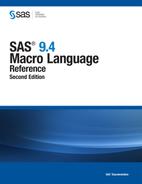Chapter 2
SAS Programs and Macro Processing
SAS Programs and Macro Processing
This section describes the typical pattern that SAS follows to process a program. These concepts are helpful for understanding how the macro processor works with other parts of SAS. However, they are not required for most macro programming. They are provided so that you can understand what is going on behind the scenes.
Note: The concepts in this section present a logical representation, not a detailed physical representation, of how SAS software works.
When you submit a program, it goes to an area of memory called the input stack. This is true for all program and command sources: the SAS windowing environment, the SCL SUBMIT block, the SCL COMPILE command, or from batch or noninteractive sessions. The input stack shown in the following figure contains a simple SAS program that displays sales data. The first line in the program is the top of the input stack.
Figure 2.1 Submitted Programs Are Sent to the Input Stack
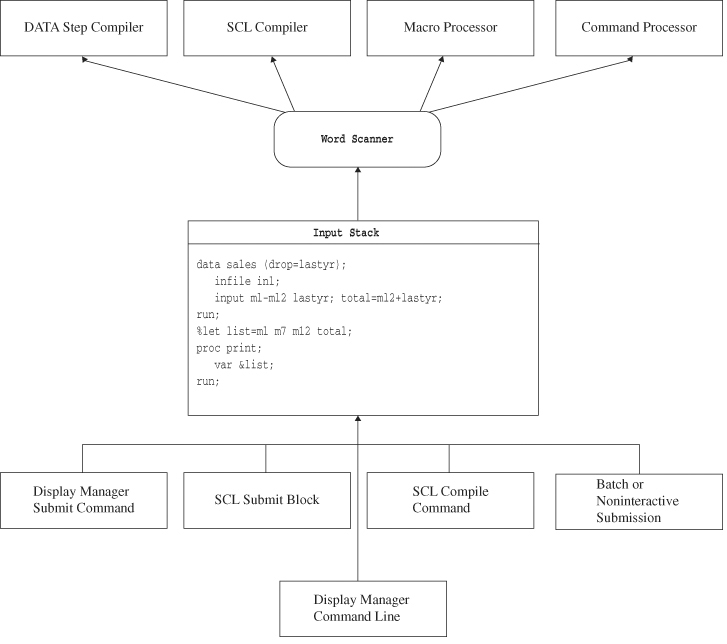
Once a program reaches the input stack, SAS transforms the stream of characters into individual tokens. These tokens are transferred to different parts of SAS for processing, such as the DATA step compiler and the macro processor. Knowing how SAS recognizes tokens and how they are transferred to different parts of SAS will help you understand how the various parts of SAS and the macro processor work together. Also, how to control the timing of macro execution in your programs. The following sections show you how a simple program is tokenized and processed.
How SAS Processes Statements without Macro Activity
The process that SAS uses to extract words and symbols from the input stack is called tokenization. Tokenization is performed by a component of SAS called the word scanner, as shown in Figure 2.2 on page 15. The word scanner starts at the first character in the input stack and examines each character in turn. In doing so, the word scanner assembles the characters into tokens. There are four general types of tokens:
Literal
a string of characters enclosed in quotation marks.
digits, date values, time values, and hexadecimal numbers.
Name
a string of characters beginning with an underscore or letter.
Special
any character or group of characters that have special meaning to SAS. Examples of special characters include: * / + - ** ; $ ( ) . & % =
Figure 2.2 The Sample Program before Tokenization
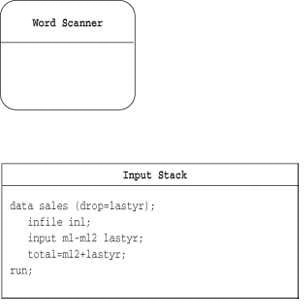
The first SAS statement in the input stack in the preceding figure contains eight tokens (four names and four special characters).
data sales(drop=lastyr);
When the word scanner finds a blank or the beginning of a new token, it removes a token from the input stack and transfers it to the bottom of the queue.
In this example, when the word scanner pulls the first token from the input stack, it recognizes the token as the beginning of a DATA step. The word scanner triggers the DATA step compiler, which begins to request more tokens. The compiler pulls tokens from the top of the queue, as shown in the following figure.
Figure 2.3 The Word Scanner Obtains Tokens
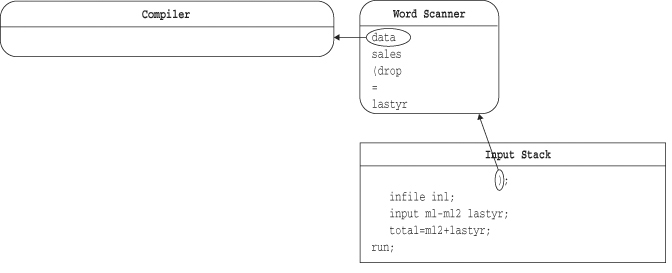
The compiler continues to pull tokens until it recognizes the end of the DATA step (in this case, the RUN statement), which is called a DATA step boundary, as shown in the following figure. When the DATA step compiler recognizes the end of a step, the step is executed, and the DATA step is complete.
Figure 2.4 The Word Scanner Sends Tokens to the Compiler

In most SAS programs with no macro processor activity, all information that the compiler receives comes from the submitted program.
How SAS Processes Statements with Macro Activity
In a program with macro activity, the macro processor can generate text that is placed on the input stack to be tokenized by the word scanner. The example in this section shows you how the macro processor creates and resolves a macro variable. To illustrate how the compiler and the macro processor work together, the following figure contains the macro processor and the macro variable symbol table. SAS creates the symbol table at the beginning of a SAS session to hold the values of automatic and global macro variables. SAS creates automatic macro variables at the beginning of a SAS session. For the sake of illustration, the symbol table is shown with only one automatic macro variable, SYSDAY.
Figure 2.5 The Macro Processor and Symbol Table
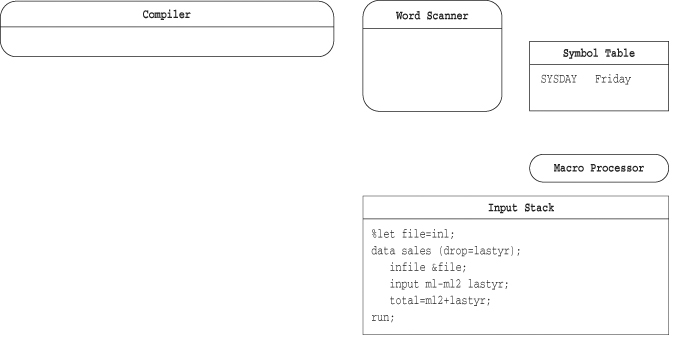
Whenever the word scanner encounters a macro trigger, it sends information to the macro processor. A macro trigger is either an ampersand (&) or percent sign (%) followed by a nonblank character. As it did in the previous example, the word scanner begins to process this program by examining the first characters in the input stack. In this case, the word scanner finds a percent sign (%) followed by a nonblank character. The word scanner recognizes this combination of characters as a potential macro language element, and triggers the macro processor to examine % and LET, as shown in the following figure.
Figure 2.6 The Macro Processor Examines LET
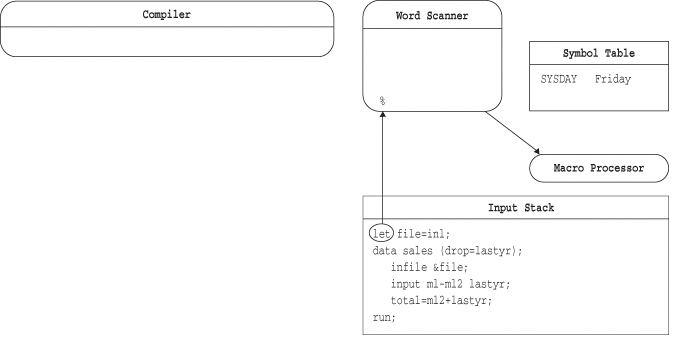
When the macro processor recognizes a macro language element, it begins to work with the word scanner. In this case, the macro processor removes the %LET statement, and writes an entry in the symbol table, as shown in the following figure.
Figure 2.7 The Macro Processor Writes to the Symbol Table

From the time the word scanner triggers the macro processor until that macro processor action is complete, the macro processor controls all activity. When the macro processor is active, no activity occurs in the word scanner or the DATA step compiler.
When the macro processor is finished, the word scanner reads the next token (the DATA keyword in this example) and sends it to the compiler. The word scanner triggers the compiler, which begins to pull tokens from the top of the queue, as shown in the following figure.
Figure 2.8 The Word Scanner Resumes Tokenization
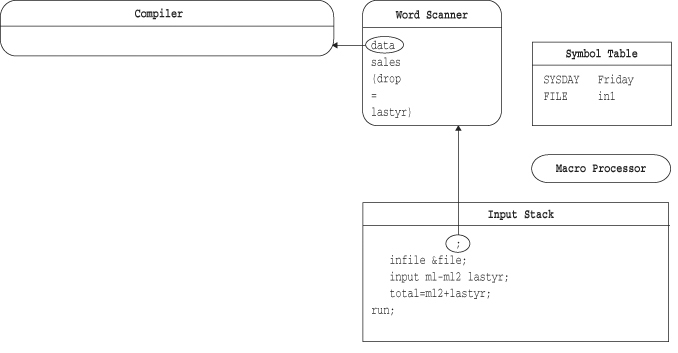
As it processes each token, SAS removes the protection that the macro quoting functions provide to mask special characters and mnemonic operators. For more information, see “Macro Quoting” on page 84.
If the word scanner finds an ampersand followed by a nonblank character in a token, it triggers the macro processor to examine the next token, as shown in the following figure.
Figure 2.9 The Macro Processor Examines &FILE

The macro processor examines the token and recognizes a macro variable that exists in the symbol table. The macro processor removes the macro variable name from the input stack and replaces it with the text from the symbol table, as shown in the following figure.
Figure 2.10 The Macro Processor Generates Text to the Input Stack
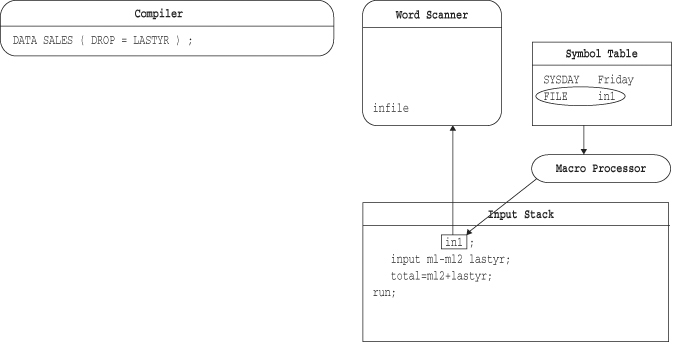
The compiler continues to request tokens, and the word scanner continues to supply them, until the entire input stack has been read as shown in the following figure.
Figure 2.11 The Word Scanner Completes Processing
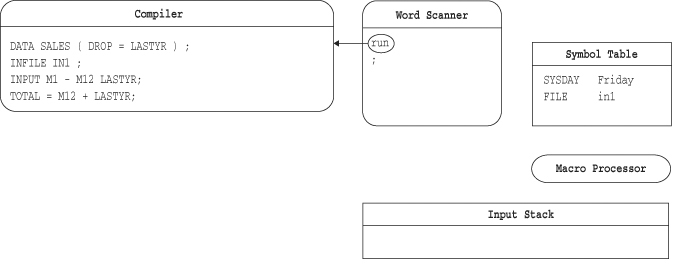
If the end of the input stack is a DATA step boundary, as it is in this example, the compiler compiles and executes the step. SAS then frees the DATA step task. Any macro variables that were created during the program remain in the symbol table. If the end of the input stack is not a step boundary, the processed statements remain in the compiler. Processing resumes when more statements are submitted to the input stack.
